1957
1957 An in-house research effort was started at RSA from which evolved the automatic infrared command guidance concept on which the tube-launched, optically-tracked, wire-guided (TOW)/Heavy Antitank Weapon (HAW) system was based.
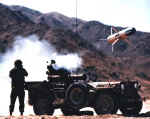
January 57 Formal development of the Phase II (or optimum) LITTLEJOHN system began.
1 January 57 Redstone Arsenal's Finance and Accounting Division began withholding Social Security (FICA) taxes from military pay beginning this date.
8 January 57 The ABMA Commander officially announced the Navy's withdrawal from the JUPITER program.
8 January 57 The New York Times reported the Army's disclosure that a document which "...apparently contained secret information" on the Army's missile missions was discovered in the hands of unauthorized persons. The Army began investigating a possible security violation involving COL John C. Nickerson, Jr., Chief of the Field Coordinating Office at ABMA.
11 January 57 The Army and Air Force approved an order to fluoridate water at military installations where children lived. Redstone Arsenal was one of ten posts where this process was already in use.
20 January 57 Six officials representing the Federal Republic of Germany arrived for an orientation tour of the arsenal. Invited to this country by DA, this West German group was the first ever to visit Redstone.

21 January 57 A complete REDSTONE missile, towed on an R&D trailer, was first displayed to the public during Eisenhower's second Presidential Inaugural Parade. Soldiers from Redstone Arsenal, ABMA, and OGMS participated in the parade held in Washington, D.C.
29 January 57 The LACROSSE missile was unveiled at Redstone.
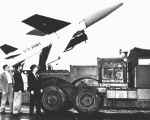
February 57 Redstone Arsenal hired a civilian teacher to conduct English language classes for non-English speaking Army personnel from Puerto Rico.
February 57 The Deputy Chief of Staff for Logistics formally established the NIKE ZEUS project, with Bell Telephone Laboratories as prime contractor.
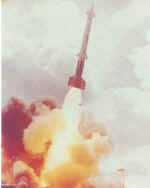
1 February 57 ABMA informed the Army Chief of R&D that the JUPITER satellite could accommodate the instrumentation of the VANGUARD payload but not the sphere itself.
2 February 57 Redstone Arsenal experienced the worst flood and largest traffic jam in its 15-year history when the Tennessee River reached its highest flood level in 75 years. The water on the arsenal was nearly 6 inches higher than in 1946 and disrupted more arsenal activities since the early days of construction in 1941. Only two gates remained opened. Helicopters were brought in to monitor flood conditions and to prevent the possible isolation of RSA and ABMA headquarters.
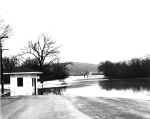
5 February 57 Third Army Headquarters announced that COL John C. Nickerson, Jr. was relieved of his duties at RSA and charged with laxity concerning security and safeguarding military information. The Deputy Chief of Staff, XVIII Airborne Corps was detailed to formally investigate whether a court-martial was warranted.
17 February 57 The OGMS fourth anniversary open house featured the first public display of the LACROSSE and DART missiles.
24 February 57 Army officials were quoted by The New York Times as saying that the trial of COL John C. Nickerson, Jr. would probably grow into a major interservice policy dispute over R&D and use of missiles.
26 February 57 Secretary of Defense Charles E. Wilson announced at a press conference that the JUPITER missile program was "in effect" canceled.
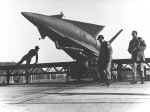
26 February 57 DOD announced the development of the NIKE HERCULES Antiaircraft Guided Missile and released the first photo showing a model of the new system.
27 February 57 MG John B. Medaris announced that the current development work on the JUPITER IRBM, the primary mission of ABMA, would continue unabated.
28 February 57 RSA deeded without cost a 21.8-acre school site on the north end of the reservation to the Huntsville City Board of Education. The property was located on the south side of Madison Pike, one-half mile west of the Madison Pike-Jordan Lane intersection.
1 March 57 The first JUPITER R&D missile was fired, but the flight was unsuccessful.
2 March 57 Redstone Arsenal called upon four Navy frogmen to locate a 6-foot long rocket that fell into the higher than usual backwater of the Wheeler Reservoir. The men, who were stationed at the Navy Mine Defense Laboratory at Panama City, Florida, spent 6 hours searching for the rocket before finding it buried in about 6 feet of mud.
14 March 57 JUPITER A Missile CC-32, the first missile shipped directly from the Chrysler factory for flight testing, was successfully launched.
18 March 57 RSA officials announced that civilian tenants of Redstone Park whose income was greater than that of a master sergeant (pay grades above GS-6, WBS-5, WG-17, or contractor pay above $4,560) were required to move from this housing area. This action was taken to provide more adequate living quarters for enlisted men with dependents. Tenants affected by this notice were required to vacate their quarters by 19 June 57.
April 57 Redstone Arsenal adopted an improved method of destroying classified material for all installation activities. Under the new method, a mobile unit destroyed classified documents by grinding them to a pulp then conveying the pulp through a chute into a dump truck. This unit, believed to be the largest of its kind in the United States, was capable of destroying material at the rate of about 1,000 pounds of paper per hour.
1 April 57 After several officials decided to base Redstone Park eviction notices for civilians on a dollar amount instead of a pay grade, additional notices were sent on this date to all other tenants having an annual salary equal to or greater than $4,525.
Tenants affected by the additional notices were required to move by 1 July 57. As these units were vacated, the Post Engineer maintenance crew completely rehabilitated them for reassignment to enlisted personnel with dependents.
9 April 57 As a backup to VANGUARD, ABMA proposed to the Army Chief of R&D that the agency use JUPITER C vehicles to orbit six satellites, each weighing about 17 pounds.
12 April 57 According to an announcement from Washington, D.C., Huntsville's housing program was slowed after the future of the Army's JUPITER missile program became uncertain.
19 April 57 Secretary of Defense Charles E. Wilson presented the Civilian Service Award, DOD's highest civilian honor, to Dr. Wernher von Braun, Chief of the ABMA Development Operations Division, for his work in the Army missile program.

19 April 57 Two test engines for the LACROSSE missile system exploded during a test at the Thiokol Chemical Corporation's facilities on Redstone Arsenal. Although damage was estimated at $4,000, there were no serious injuries.
5 May 57 Contaminated land, buildings, and material valued at about $100,000 were reclaimed and put back into use at RSA by a team of Chemical Corps personnel from the Army Chemical Center, Maryland. Work began on this date and was finished on 5 August.
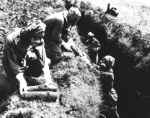
The reclaimed land was located on Dodd Road across from the ABMA Guided Missile Test Stand. Known as the "Old Boneyard," the land had been used during the 1940s as a dumping ground for contaminated materials, much of which had been buried in unmarked trenches. The rails were recovered from the former toxic gas yard near the Tennessee River, while the decontaminated buildings were located between Building 781 and Patton Road.
7 May 57 The Army Chief of R&D reiterated that no plan existed for ABMA's backup of VANGUARD.
8 May 57 It was announced that Professor Hermann Oberth, internationally known rocket and space flight research pioneer, planned to return to Germany later this year.
15 May 57 JUPITER C Missile RS-34 was fired to test thermal behavior of a scaled-down version of the JUPITER nose cone during reentry. The nose cone was not recovered; however, instrument contact with the cone through reentry indicated that the ablative-type heat protection for warheads was successful.
16 May 57 RSA established the Automatic Data Processing Systems (ADPS) Office as a special staff element reporting directly to the commanding general. The arsenal's ADPS program was based on an Ordnance Corps program which directed that national control activities be studied for conversion to electronic data processing systems during the next several years.
18 May 57 The Army's new long-range antiaircraft guided missile, the NIKE HERCULES, was displayed for the first time during Huntsville's Armed Forces Day celebration. About 2,000 troops, along with 7 military and civilian bands, participated in the town's parade.

23 May 57 Begun before the CORPORAL I was even fielded, additional effort on the improved CORPORAL II system led to the development of the CORPORAL Type III. Because of limited funds as well as development progress on the SERGEANT system, the CORPORAL III program was terminated on this date.
28 May 57 A runaway switch engine caused considerable damage to the RSA roundhouse when it got away from another engine pushing it and crashed through one of the building's walls. The 120-ton engine was unoccupied when the mishap occurred.
31 May 57 JUPITER Missile AM-1 was successfully fired by ABMA. This demonstration marked the initial U.S. flight of an IRBM. Actually, ABMA had previously fired JUPITER missiles 1A and 1B in March and April 57, respectively, but neither was fully successful. However, these flights did allow the agency to correct problems prior to the announced firing date for JUPITER I.
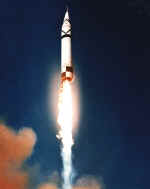
Despite this achievement, the JUPITER program remained in a precarious position because of the Navy's withdrawal from the program and the Secretary of Defense's November 56 decision to limit the Army's responsibility to missiles having ranges of 200 miles or less. In essence, ABMA was developing a missile which the Army could not use. Eventually the Soviet Union's successful launch of SPUTNIK I in October 57 resolved this problem by prompting President Eisenhower to approve development of both the JUPITER and THOR systems.

June 57 MG John B. Medaris, one of the highest ranking officers to complete flight training, received his pilot's wings from the Army Aviation School at Fort Rucker, Alabama.
1 June 57 The 630th Ordnance Company (REDSTONE), the first unit organized for supply and maintenance of the REDSTONE in the field, was activated and assigned to ABMA.
4 June 57 A serious accident at OGMS occurred when a 46-foot long CORPORAL Missile Erector ran out of control, burst into flames, then tumbled into a drainage ditch. Damage was estimated at $35,000, but the driver and his assistant escaped with superficial injuries. Preliminary investigations indicated that a faulty steering mechanism was to blame. The vehicle was not carrying a missile at the time of the accident.
9 June 57 Services were held for the first time in the new Post Chapel. Constructed at an estimated cost of $283,900, the air conditioned building could seat 250 and had facilities for a nursery, social room, Sunday school, kitchen, choir room, Chaplain's office, blessed sacrament chapel, sacristy, and confessional.

11 June 57 A 3-day conference of the American Ordnance Association's guided missile branch was held at Redstone Arsenal. During the meeting over 200 visitors saw a display of 11 major Army missiles, one of the largest exhibits of this kind to date. The conference attendees also witnessed the launching of several different rockets as well as a simulated battle during which rockets were fired from the ground and from helicopters. Among the rockets launched was the HONEST JOHN, at that time the largest weapon ever fired at Redstone.
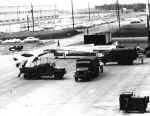
American Ordnance Association Conference
The dedication of Vincent Hall, named in honor of the late BG Thomas K. Vincent (a former RSA Commander), was another highlight of the conference.
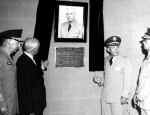
Vincent Hall Dedication
13 June 57 The explosion of about one gram of an experimental compound in one of the organic chemistry laboratories of Rohm & Haas Company's Redstone Arsenal Research Division resulted in a disabling injury to one employee. This was the first such accident experienced by the local plant in its 8 years of operation.
25 June 57 The court-martial of COL John C. Nickerson, Jr., which started on this date, was conducted in Huntsville. A total of 71 reporters covered developments in the trial. Nickerson, who pleaded guilty to 15 counts of breaching Army security regulations, faced the possibility of a 30-year prison sentence and dismissal from the service. The charges against him were based on Nickerson's release of a document containing defense secrets, along with a personal memorandum highly critical of the Defense Secretary's decision to limit the Army's missile and rocket R&D role to ranges of 200 miles or less.
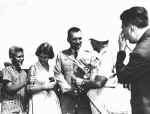
COL John C. Nickerson, Jr., after the court-martial
Seeking to establish mitigating and extenuating circumstances for Nickerson's actions, defense attorneys argued that his motive was to get permission for the Army to maintain operational control of the JUPITER missile system being developed by ABMA. Although he agreed under oath that his chosen method for influencing the Secretary of Defense was misguided, Nickerson steadfastly maintained that the decision to limit the Army's role in the field of missiles and rockets was wrong.
On 29 June 57, the general court-martial board passed a relatively light sentence on Nickerson: suspension from rank for 1 year, forfeiture of $100 pay per month for 15 months, and an official reprimand. A few weeks after his trial ended, Nickerson was assigned to duty as a construction inspector in the Panama Canal Zone.
In July 58, the Army restored full security clearance to Nickerson and reassigned him as ordnance officer of the U.S. Army Caribbean Command with headquarters in the Canal Zone. Nickerson subsequently returned to the continental United States as ordnance officer at the Air Defense Center and commanding officer of the 61st Ordnance Group at Fort Bliss, Texas. On 1 March 64, Nickerson and his wife were killed in an automobile accident near Alamagordo, New Mexico.
26 June 57 The Rocket City Astronomical Association put out the first edition of the locally edited Space Journal, a new magazine dealing with space travel and the astrosciences. The first issue was dedicated to Dr. Hermann Oberth, who was known as the "father of astronautics."

July 57 The Phase I (or interim) LITTLEJOHN system was completed as scheduled, but it failed to meet the minimum accuracy requirement. As a result, it was never released for tactical use, only training.
July to December 57 The Exchange's Mobile Canteen first began operation.

9 July 57 ABMA sent a letter to the Chief of Ordnance outlining its potential satellite launching capability.
11 July 57 MG Holger N. Toftoy, the RSA Commander, returned to duty after a 5-month illness.
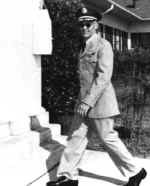
August 57 The 40th Field Artillery Missile Group (REDSTONE) was formed at Redstone Arsenal and began training this month. This was the Army's first missile battalion.
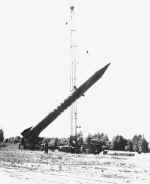
August 57 The 101st Airborne Division, Fort Campbell, Kentucky, received the initial issue of Phase I LITTLEJOHN units. However, the Continental Army Command (CONARC) subsequently decided that the weapon system was unsuitable for general troop use. The interim LITTLEJOHN was retained for training and development of combat techniques pending the availability of the optimum system.
8 August 57 JUPITER C Missile RS-40, a modified REDSTONE, was successfully launched. Its nose cone was the first to be recovered from outer space. It also carried the first mail ever delivered over IRBM range.
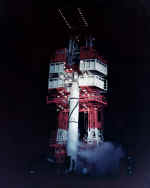
13 August 57 The Secretary of Defense advised the Secretary of the Army that, in accordance with a presidential decision, an ad hoc committee of three members was established to work out a single land-based IRBM. This group was known as the Holaday Committee after its chairman, W.M. Holaday, an OSD member.
21 August 57 Because of the success of JUPITER C Missile RS-40, ABMA discontinued all further scheduled flight tests using JUPITER C and concentrated instead on further reentry work on the full-scale JUPITER nose cone.
28 August 57 JUPITER Missile AM-2 was fired from Cape Canaveral, Florida, over IRBM range. This was the first test of body and thrust unit Septemberaration.
September 57 Redstone Arsenal laid claim to the distinction of having the Army's best educated soldiers, at an average educational level of 13.42 years.
9 September 57 The U.S. government took possession of the Wherry Housing Program (Weeden Manor) on RSA, following a civil suit in the U.S. District Court, Birmingham, Alabama, against the private owners of the units. The cost to acquire these buildings totaled over $1 million. Arsenal land for the program had been leased to Redstone Homes, Inc., a corporation of Mississippi stockholders that built 120 housing units. Originally rented to both government connected civilians and military personnel, these units were officially redesignated as "public quarters" effective 1 October 57 and were assigned to military personnel only. The four remaining civilian tenants were served with eviction notices and had to vacate their quarters by 15 January 58.
9 September 57 The 40th Field Artillery Missile Group (REDSTONE) was reorganized as the 40th Field Artillery Missile Group (Heavy). It was the first heavy missile group to be organized in the history of the United States.
9 September 57 The first REDSTONE missile firing in which troops participated occurred on this date.
October 57 For the first time in 5 years, the Ordnance Corps Certificate of Merit for Safety for 1956 was awarded to the three agencies located at Redstone Arsenal.
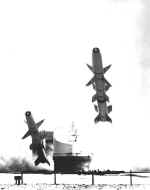
October 57 The Army undertook the evaluation of the land-based TALOS, an antiaircraft missile being developed by the Navy.
3 October 57 The arsenal established the Redstone Anti-Missile Missile Systems Office (RAMMSO) to manage the NIKE ZEUS program. Before the office became fully operational, however, RSA's responsibility for the NIKE ZEUS was transferred to the Army Rocket and Guided Missile Agency (ARGMA) on 1 April 58. RAMMSO was abolished on 14 April 58.
4 October 57 The Soviet Union launched SPUTNIK I, the first man-made earth satellite. It remained in orbit until 4 January 58.
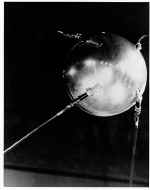
7 October 57 The Secretary of the Army wrote to the Secretary of Defense regarding the significance of SPUTNIK. He recommended using the JUPITER C for an earlier satellite launch.
17 October 57 ABMA established the JUPITER Project Office under the Control Office to coordinate the ground support equipment (GSE) program with the USAF. Later the office assumed responsibility for all aspects of the JUPITER program.
19 October 57 The Secretary of Defense directed the ABMA Commander, as a matter of highest national urgency, to proceed with all actions required to prepare for JUPITER initial operational capability (IOC) missile production and to undertake immediately the fabrication of proto-types of JUPITER peculiar GSE.
November 57 The Martin Company delivered the first production prototype LACROSSE missile.
3 November 57 The Soviet Union launched the world's second man-made satellite, SPUTNIK II. It remained in orbit until 13 April 58.
7 November 57 In a major televised address on science and security, President Eisenhower announced that Army scientists had successfully solved the problem of ballistic missile reentry. Shown as part of the broadcast was the JUPITER C nose cone recovered on 8 August 57.
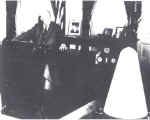
8 November 57 The Secretary of Defense ordered ABMA to prepare a JUPITER C missile to launch a satellite as part of the International Geophysical Year (IGY) program. After the Soviet launch of SPUTNIK I on 4 October 57, the Secretary of the Army had submitted a proposal for a satellite using the JUPITER C missile, which the Army believed it could launch sooner than Project VANGUARD, the satellite program on which the United States had previously relied.
15 November 57 Effective this date, a new building numbering system was installed at RSA. Under this plan, the arsenal was divided into 10 major sectors, including Redstone Park.
20 November 57 The Secretary of the Army recommended to the Secretary of Defense that 30 January and 6 March 58 be approved as launching dates for the first two JUPITER C satellites. Later that same day, the Secretary of the General Staff advised that these dates were approved.
22 November 57 The OSD Director of Guided Missiles instructed the Army to launch two JUPITER C satellites to carry the cosmic radiation package prepared by Dr. James Van Allen of the University of Iowa.
27 November 57 The Air Force was directed to proceed with the operational deployment of both THOR and JUPITER.
December 57 The contractor delivered the first NIKE HERCULES missile during this month.
December 57 ABMA submitted to DOD a "Proposal for a National Integrated Missile and Space Vehicle Development Program." This historic document suggested the need for a booster of 1.5 million pounds thrust.
The ABMA/AOMC Era:
Introduction,
1956,
1957,
1958,
1959,
1960,
1961,
1962

